Called the Keystone State or the Quaker State, Pennsylvania has one of the most diverse geographies and the highest number of navigable rivers! Its territory is part of the eastern deciduous forest region, and the state’s northern region is covered in hardwood forests. The southern two-thirds consist of the Appalachian oak forest.
This book on Pennsylvania plants shows that the state hosts around 3,400 species of plants, and more than half are native! Today, we’ll tell you about some native plants in Pennsylvania!

1. Dwarf Crested Iris

The dwarf crested iris has yellow rhizomes with green or white shades.
©iStock.com/Gerald G Gantar
| Dwarf-Crested Iris | |
|---|---|
| Scientific name | Iris cristata |
| Other common names | Crested Iris |
| Type of plant | Rhizomatous perennial |
| Distribution | Eastern United States |
The dwarf crested iris is endemic to the eastern United States, where it grows in oak woodlands, ravines, on rocky hillsides, and along streams, preferring calcareous soils.
The plant has yellow rhizomes with green or white shades. It has up to eight brown branches from which stolons grow.
There are 6-8 basal leaves and 4-5 other distal leaves. The stems are almost absent, as they’re very short, but they bear the green spathes, meaning flower bud leaves, each with 1-2 flowers. The crested iris blooms between April and May, sometimes in early summer, and produces blue, lilac, pale blue, lavender, or purple flowers. Afterward, the seed capsule appears, which contains yellowish-brown seeds.
2. Eastern Redbud
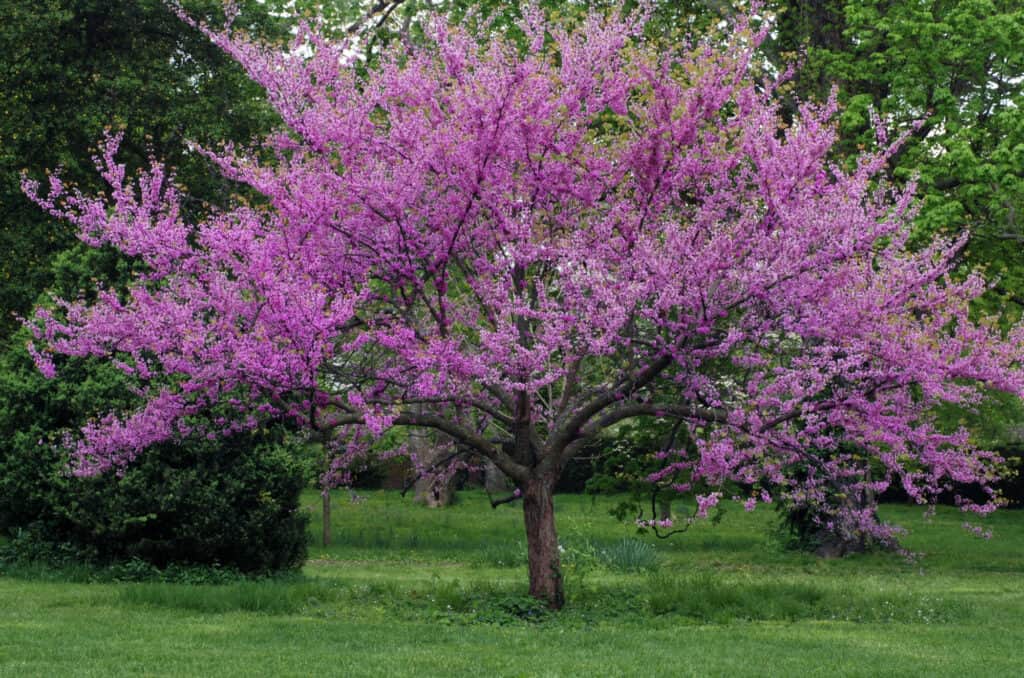
Eastern redbud trees reach up to 30 feet high.
©Marie C Fields/Shutterstock.com
| Eastern Redbud | |
|---|---|
| Scientific name | Cercis canadensis |
| Type of plant | Deciduous shrub or small tree |
| Distribution | Eastern North America |
The eastern redbud definitely stands out in the wild, thanks to its gorgeous pink flowers!
The eastern redbud grows up to 20-30 feet tall and has a 26-33 foot spread. The trunk is usually short and twisted and has a dark bark, which is smooth to the touch. Eastern redbud leaves are alternately arranged and have a heart shape. On the other hand, the flowers appear from spring to early summer and have a distinctive pink color, attracting carpenter and blueberry bees. From August to October, the brown pea-like pods ripen.
Besides attracting pollinators, eastern redbud leaves are a food source for caterpillars. While they can cause extensive defoliation, they aren’t known to cause any long-term damage to the tree.
3. Coastal Plain Joe Pye Weed
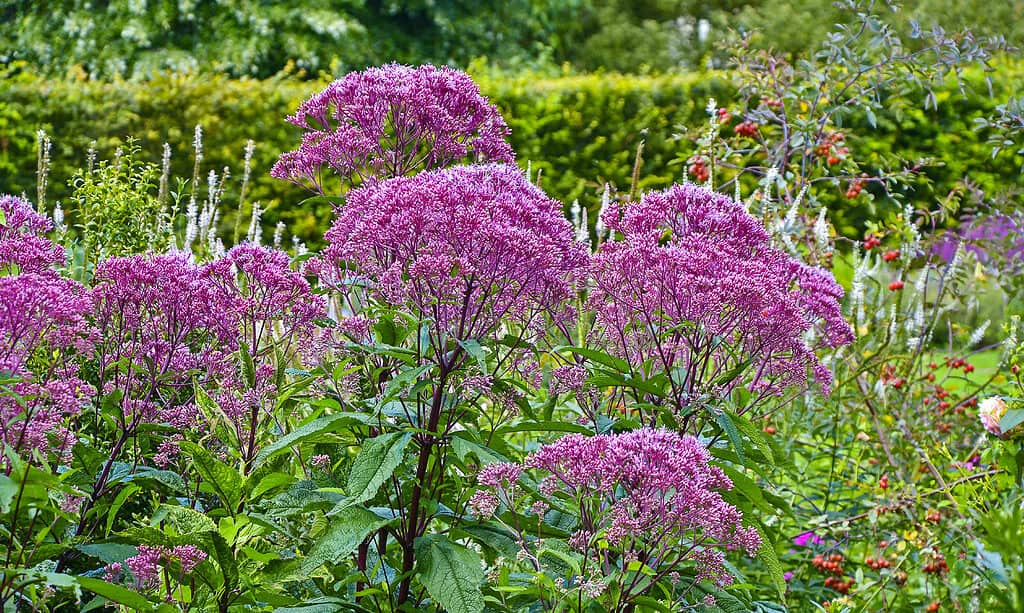
The coastal plain Joe Pye weed grows only on the eastern North American coast, from Georgia to Nova Scotia.
©Gardens by Design/Shutterstock.com
| Coastal Plain Joe Pye Weed | |
|---|---|
| Scientific name | Eupatorium dubium |
| Type of plant | Herbaceous perennial |
| Distribution | Eastern United States and Canada |
The Eupatorium dubium, also called the coastal plain Joe Pye weed, grows only on the eastern North American coast, from Georgia to Nova Scotia.
The plant reaches up to around 5 feet and produces purple or green stems. The flower heads have 4-10 disc florets that become dark purple when they fully bloom. Sometimes they can be pink or white. These outstanding flowers attract numerous birds!
If you’re planning to grow this Pennsylvania native plant in your garden, you shouldn’t have any issues with it as long as you plant it in full sun to part shade and ensure its soil doesn’t dry out.
4. Dense Blazing Star
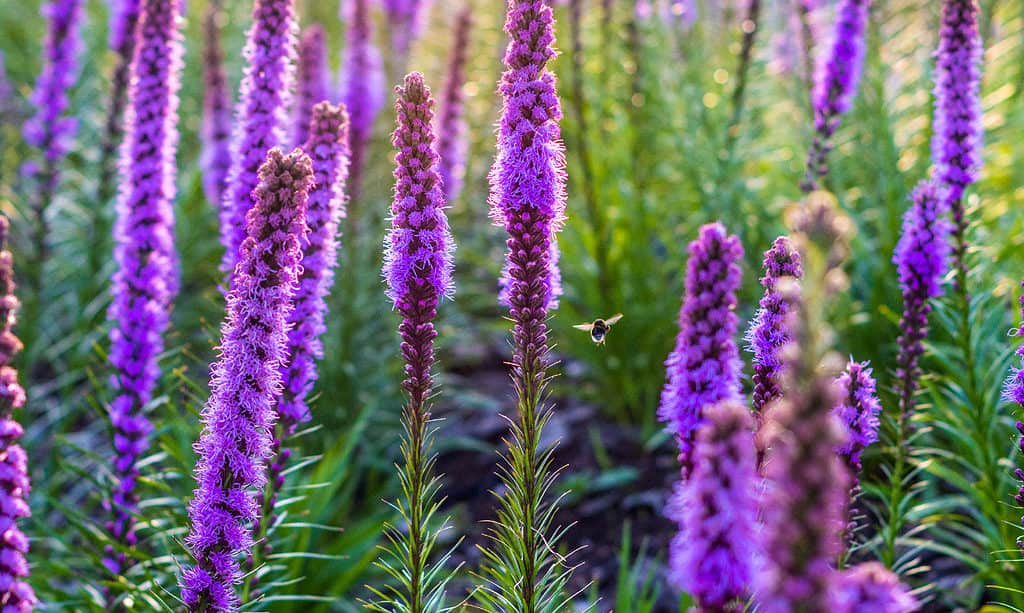
The dense blazing star thrives in sedge meadows and moist prairies.
©iStock.com/Natalya Mamaeva
| Dense Blazing Star | |
|---|---|
| Scientific name | Liatris spicata |
| Other common names | Prairie feather |
| Type of plant | Herbaceous perennial |
| Distribution | Eastern North America |
The dense blazing star, or the prairie feather, thrives in sedge meadows and moist prairies and is native to eastern North America, including Pennsylvania. It’s a widely cultivated plant found in many gardens around the world. People choose it for their yards due to its rich purple flowers that bloom from July to August or September. However, some dense blazing star varieties produce white flowers.
In its natural habitat, the prairie feather attracts butterflies, bumblebees, skippers, and hummingbirds, among other insects and birds. Moreover, if you’re planning to add this herbaceous perennial to your garden, you should know it’s considered deer-resistant.
5. Scarlet Beebalm
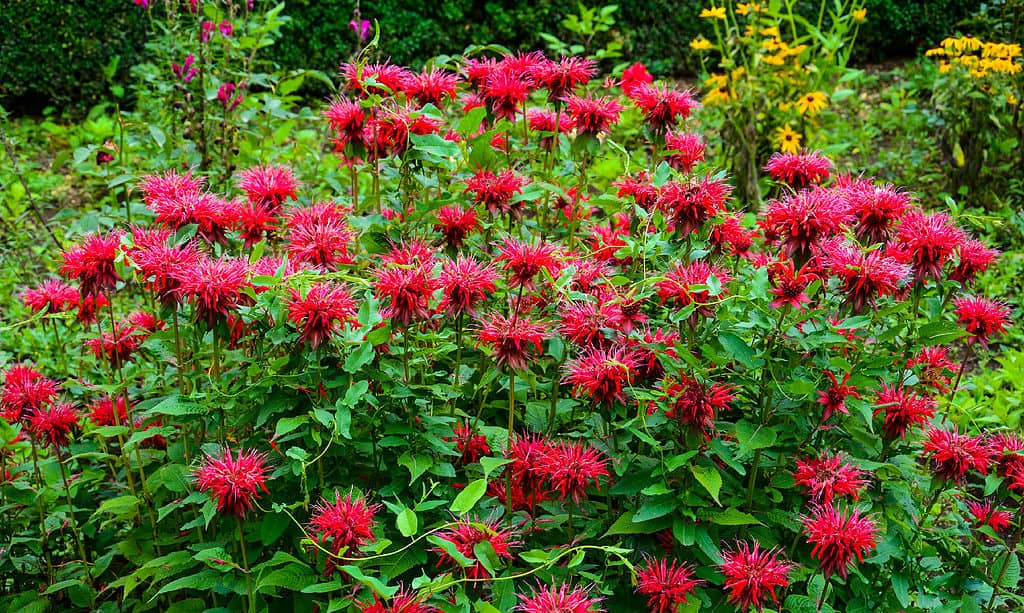
The scarlet beebalm features ovate to ovate-lanceolate deep green leaves with serrated margins.
©Vahan Abrahamyan/Shutterstock.com
| Scarlet Beebalm | |
|---|---|
| Scientific name | Monarda didyma |
| Other common names | Eau-de-Cologne plant, crimson beebalm, scarlet monarda, Oswego tea, bergamot |
| Type of plant | Perennial herb |
| Distribution | Eastern North America |
You might hear about this plant under various names, including scarlet beebalm. The plant is famous among plant enthusiasts thanks to its special fragrance, similar to that of the bergamot orange, which is added to Earl Grey tea.
The scarlet beebalm grows to 3.9 feet tall and features ovate to ovate-lanceolate deep green leaves with serrated margins. When crushed, the leaves give off a mint scent. The herb blooms from early to late summer and produces bright red tubular flowers. They grow on flower heads consisting of about 30 flowers, which attract hummingbirds.
Gardeners often choose it as an ornamental plant due to its pleasing appearance and adaptability.
6. Black Chokeberry
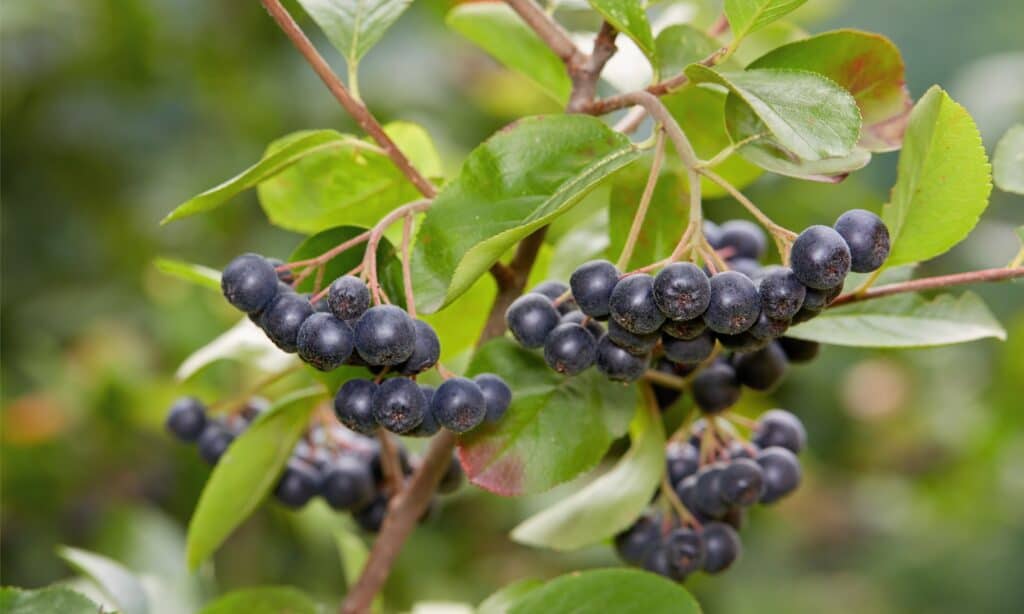
The black chokeberry shrub is a food source for some bird species.
©iStock.com/gojak
| Black Chokeberry | |
|---|---|
| Scientific name | Aronia melanocarpa |
| Type of plant | Branching shrub |
| Distribution | Eastern North America |
The black chokeberry shrub has glossy dark green leaves and white or pink flowers. This branching shrub blooms in late spring, while the fruits appear in September. When fall sets in, the leaves turn a brilliant red color, and the shrub produces black berries as fruits. They are often used in various recipes. Although they’re astringent when raw, black chokeberry fruits taste better when combined with sugar. They are also a food source for some bird species.
7. Witch-Hazel
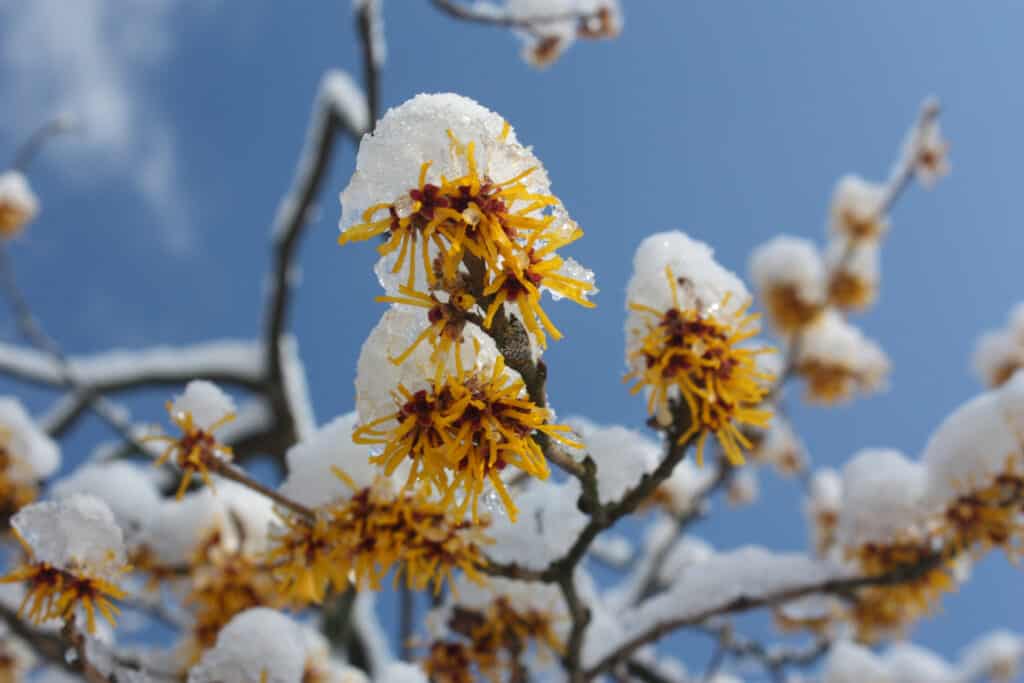
Witch-hazel’s most distinctive characteristic is that it blooms mid-fall and produces flowers until late fall.
©iStock.com/odluap
| Witch-Hazel | |
|---|---|
| Scientific name | Hamamelis virginiana |
| Other common names | Common witch-hazel, American witch-hazel |
| Type of plant | Deciduous shrub or small tree |
| Distribution | Eastern North America |
This deciduous plant can grow either as a shrub or a tree, typically reaching heights of 19.6 feet and featuring a dense stem cluster at its base. The witch-hazel has light brown, smooth bark, while the inner bark is reddish-purple. When fully grown, the leaves are oval and have dark green tops and pale undersides. During fall, they become yellow and have rusty spots.
The plant’s most distinctive characteristic is that it blooms mid-fall and produces flowers until late fall. At the time, it reveals its pale to bright yellow flowers with four ribbon-like petals. Just imagine the combination — yellow leaves and bright yellow flowers!
8. Wood Geranium
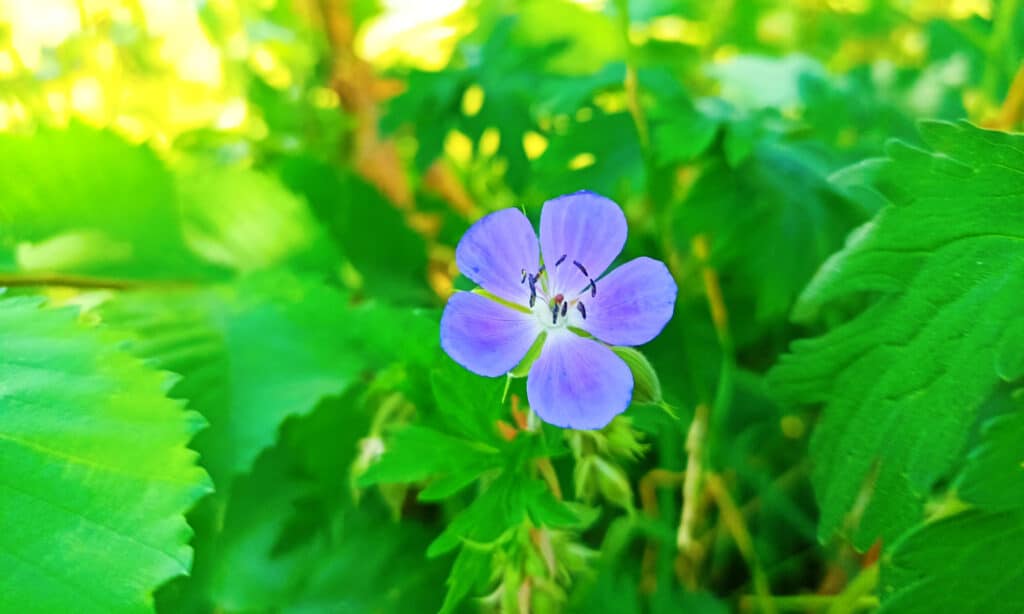
The wood geranium is a herbaceous perennial with upright stems that have no branches.
©iStock.com/Natalila Paziura
| Wood Geranium | |
|---|---|
| Scientific name | Geranium maculatum |
| Other common names | Spotted geranium, wild geranium |
| Type of plant | Herbaceous perennial |
| Distribution | Eastern North America |
The wood geranium is a herbaceous perennial with upright stems that have no branches. Its leaves have 5-7 deeply cut lobes, while the flowers have five rose-purple, rarely white, petals. The plant blooms in various months, depending on where it grows. In the Northern Hemisphere, for instance, it flowers from April to June.
This plant is widely cultivated and has numerous cultivars, the most famous being the ‘Elizabeth Ann,’ which won the Royal Horticultural Society’s Award of Green Merit. Besides being an ornamental plant, the wood geranium is known to have medicinal properties and is believed to be able to stop bleedings and ease toothaches.
9. Swamp Milkweed

Swamp milkweed is added to many gardens for its unique appearance and ability to attract butterflies.
©iStock.com/Cynthia Shirk
| Swamp Milkweed | |
|---|---|
| Scientific name | Asclepias incarnata |
| Other common names | Rose milkweed, swamp silkweed, white Indian hemp, rose milkflower |
| Type of plant | Herbaceous perennial |
| Distribution | North America |
With its pink to mauve flowers, the swamp milkweed is often at the top of the list for plant enthusiasts and gardeners. Many cultivars have been developed, and the plant is added to many gardens thanks to its unique appearance and ability to attract butterflies.
In the wild, it grows near lakes and streams, where it attracts many monarch butterflies.
The swamp milkweed has branched stems and oppositely arranged leaves. It blooms from early to mid-summer, unraveling its small, fragrant flowers that sometimes can have a white color.
10. Tuliptree
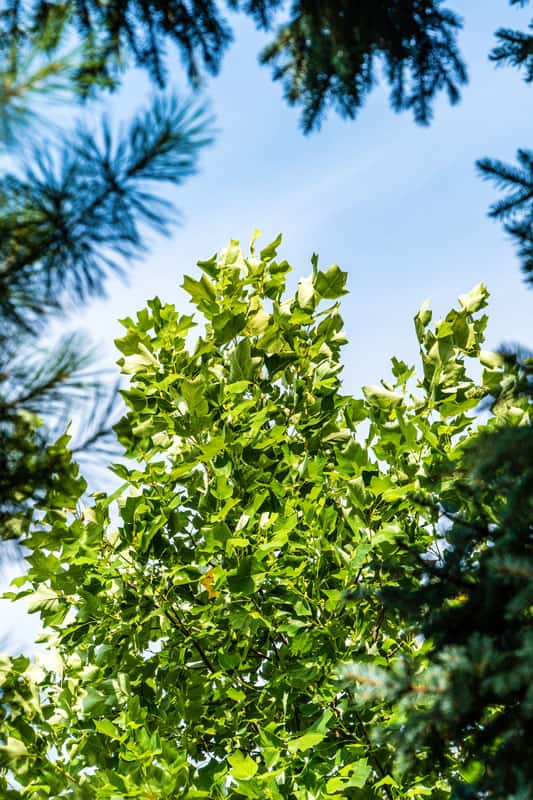
The tuliptree is North America’s tallest hardwood, growing to 192 feet.
©Alexander Denisenko/Shutterstock.com
| Tuliptree | |
|---|---|
| Scientific name | Liriodendron tulipifera |
| Other common names | Tulip poplar, fiddletree, yellow-poplar, tulipwood |
| Type of plant | Hardwood tree |
| Distribution | Eastern North America |
The tuliptree is North America’s tallest hardwood, reaching heights of up to 192 feet and having a trunk diameter of up to 6 feet! The tuliptree branchlets are reddish when young, becoming dark gray and brown as the tree matures. The heart-shaped leaves are alternately arranged and have four lobes.
This tree blooms in May, producing greenish-yellow cup-shaped flowers with six petals arranged in two rows. The fruit is a light brown cone that appears in September and October.
Numerous hardwood cultivars have been developed that are now used in landscaping.
11. Christmas Fern

The Christmas fern is popular ornamental plant as it doesn’t require much care and is highly adaptable.
©Young Swee Ming/Shutterstock.com
| Christmas Fern | |
|---|---|
| Scientific name | Polystichum acrostichoides |
| Type of plant | Perennial evergreen fern |
| Distribution | Eastern North America |
The Christmas fern has a clumping growth habit. The black stem is covered in light brown, translucent scales, while the fronds are dark green, leathery to the touch, and slightly hairy on the underside. The leaves have 20-35 pairs of pinnae with spiny edges and oblong to falcate shapes. While it can form colonies, the fern usually grows singly or in groups of up to three plants.
It’s a popular ornamental plant because it doesn’t require too much care and is highly adaptable. Moreover, since it’s evergreen and only its fertile fronds die in winter, the Christmas fern is often used in winter gardens.
Summary of 11 Native Plants in Pennsylvania
Here’s a recap of the 11 plants native to the state of Pennsylvania that we took a look at.
| Number | Plant | Scientific Name | Plant Type | Distribution |
|---|---|---|---|---|
| 1 | Dwarf Crested Iris | Iris cristata | Rhizomatous perennial | Eastern United States |
| 2 | Eastern Redbud | Cercis canadensis | Deciduous shrub or small tree | Eastern North America |
| 3 | Coastal Plain Joe Pye Weed | Eupatorium dubium | Herbaceous perennial | Eastern United States and Canada |
| 4 | Dense Blazing Star | Liatris spicata | Herbaceous perennial | Eastern North America |
| 5 | Scarlet Beebalm | Monarda didyma | Perennial herb | Eastern North America |
| 6 | Black Chokeberry | Aronia melanocarpa | Branching shrub | Eastern North America |
| 7 | Witch-Hazel | Hamamelis virginiana | Deciduous shrub or small tree | Eastern North America |
| 8 | Wood Geranium | Geranium maculatum | Herbaceous perennial | Eastern North America |
| 9 | Swamp Milkweed | Asclepias incarnata | Herbaceous perennial | North America |
| 10 | Tuliptree | Liriodendron tulipifera | Hardwood tree | Eastern North America |
| 11 | Christmas Fern | Polystichum acrostichoides | Perennial evergreen fern | Eastern North America |
The photo featured at the top of this post is © iStock.com/Marine2844
Sources
- Pennsylvania DCNR, Available here: https://www.dcnr.pa.gov/Conservation/WildPlants/LandscapingwithNativePlants/Pages/default.aspx
- Pennsylvania DCNR, Available here: https://elibrary.dcnr.pa.gov/GetDocument?docId=1742582&DocName=sf-Native_Plants_Landscaping-brochure.pdf
- Pennsylvania Native Plant Society, Available here: https://www.panativeplantsociety.org/
- Pennsylvania Native Plant Society, Available here: https://www.panativeplantsociety.org/uploads/1/7/8/2/17829397/birdy_dozen_2022.jpg
Thank you for reading! Have some feedback for us? Contact the AZ Animals editorial team.







